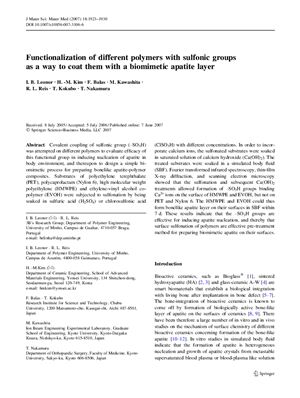Joual of Materials Science: Materials in Medicine, 2007, Vol. 18,
p. 1923–1930
Abstract Covalent coupling of sulfonic group (–SO3H) was attempted on different polymers to evaluate efficacy of this functional group in inducing nucleation of apatite in body environment, and thereupon to design a simple biomimetic process for preparing bonelike apatite-polymer composites. Substrates of polyethylene terephthalate (PET), polycaprolactam (Nylon 6), high molecular weight polyethylene (HMWPE) and ethylene-vinyl alcohol copolymer (EVOH) were subjected to sulfonation by being soaked in sulfuric acid (H2SO4) or chlorosulfonic acid (ClSO3H) with different concentrations. In order to incorporate calcium ions, the sulfonated substrates were soaked in saturated solution of calcium hydroxide (Ca(OH)2). The treated substrates were soaked in a simulated body fluid (SBF). Fourier transformed infrared spectroscopy, thin-film X-ray diffraction, and scanning electron microscopy showed that the sulfonation and subsequent Ca(OH)2 treatments allowed formation of –SO3H groups binding Ca2+ ions on the surface of HMWPE and EVOH, but not on PET and Nylon
6. The HMWPE and EVOH could thus form bonelike apatite layer on their surfaces in SBF within 7 d. These results indicate that the –SO3H groups are effective for inducing apatite nucleation, and thereby that surface sulfonation of polymers are effective pre-treatment method for preparing biomimetic apatite on their surfaces.
Abstract Covalent coupling of sulfonic group (–SO3H) was attempted on different polymers to evaluate efficacy of this functional group in inducing nucleation of apatite in body environment, and thereupon to design a simple biomimetic process for preparing bonelike apatite-polymer composites. Substrates of polyethylene terephthalate (PET), polycaprolactam (Nylon 6), high molecular weight polyethylene (HMWPE) and ethylene-vinyl alcohol copolymer (EVOH) were subjected to sulfonation by being soaked in sulfuric acid (H2SO4) or chlorosulfonic acid (ClSO3H) with different concentrations. In order to incorporate calcium ions, the sulfonated substrates were soaked in saturated solution of calcium hydroxide (Ca(OH)2). The treated substrates were soaked in a simulated body fluid (SBF). Fourier transformed infrared spectroscopy, thin-film X-ray diffraction, and scanning electron microscopy showed that the sulfonation and subsequent Ca(OH)2 treatments allowed formation of –SO3H groups binding Ca2+ ions on the surface of HMWPE and EVOH, but not on PET and Nylon
6. The HMWPE and EVOH could thus form bonelike apatite layer on their surfaces in SBF within 7 d. These results indicate that the –SO3H groups are effective for inducing apatite nucleation, and thereby that surface sulfonation of polymers are effective pre-treatment method for preparing biomimetic apatite on their surfaces.

